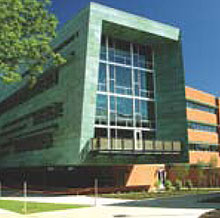Architecture Defined By Copper
Copper has played an important role in the design and architecture of all types of structures for thousands of years. In ancient Egypt, the massive doors to the temple of Amen-Re at Karnak were clad with copper. The 162-foot-tall, nine-story Loha Maha Paya temple built in the third century B.C. in Sri Lanka sparkled with copper roof shingles. Copper was an integral part of European medieval architecture and today, some 10,000 years after it was first discovered by mankind, architects and building designers are finding new and innovative ways to use copper in their designs.
Copper is a superior roofing and cladding material when compared to traditional alternatives like asphalt or clay. Durable, and entirely recyclable, copper is long lasting and virtually maintenance-free.
Copper at the University
Copper often plays and important role in institutional architecture, which is typically designed to last for generations. Look at college campuses today and you are likely to see copper featured in the architecture. The landmark Foellinger Auditorium at the University of Illinois, the centerpiece of Thomas Jefferson's University of Virginia's campus, features a copper roof and cornice. The skyline of Saint Louis is illuminated by the copper roofs that highlight almost every building on the campus of Saint Louis University.
While copper campus roofs are typical, we are seeing a growing trend at replacing traditional ivy-covered brick walls with copper. Saint Joseph's College in Standish, Maine, recently capped its first expansion in fifty years with a 50,000 square foot copper-clad classroom facility.
The 2003, expansion of the University of Minnesota's College of Architecture and Landscape, designed by TIME magazine architect of the year Steve Holl, also stands out due to its copper cladding.
According to Tom Fisher, dean of the Architecture College, "The copper on Ralph Rapson Hall did several things for us. Its initial color came close to that of the adjacent brick building, while its eventual patina green color will help it blend with the foliage in the four gardens around the addition. The copper's horizontal raised-seams also tied the addition to the horizontal brick coursing of the original building, while catching the snow in winter as a series of white lines against the metal surface. Best of all: because of the lightness of the copper, it allowed us to have a lighter structure, reducing the overall cost of the building."
The new architecture school at Pennsylvania State University followed a similar line of thought. The building features a pre-patinated copper facade that encompasses the entire structure. The copper cladding, fabricated from 95 percent recycled copper, was chosen for its long life cycle and maintenance-free reliability, as well as its aesthetic appearance. As with Rapson Hall, the rich copper color and maturing green patina of the Penn State structure blends exceptionally well with its rural environment and the changing seasonal colors that form a backdrop for the campus.
Faith and Copper
Copper also plays a very prominent role in the architecture and design of houses of worship. The Beth Sholom Synagogue near Philadelphia was designed in the 1950s by Frank Lloyd Wright and features a traditional copper laver, or fountain, used by worshippers to purify themselves before entering the temple. One of the largest churches in the Midwest, the First United Methodist Church of Jackson, Michigan, was recently restored with a shining copper shingle roof. And another of the largest religious institutions in the country, The Church of the Epiphany in Houston, Texas, replaced its asphalt roof with copper in 2003.
One recent renovation worth noting is St. Joesph's Church in Fayetteville, Arkansas. After years of slow deterioration from ice, snow, wind and other elements, the church decided to replace its original asphalt shingle roof with copper. According to Joe Koch, business manager for St. Joseph's, "The reason we chose copper is because it's long-lasting and we don't want to have to reroof right away."
The church considered reroofing with asphalt composite shingles but quickly decided on the copper alternative. They found the cost of materials to be closely competitive, even though the average lifespan of asphalt roofs may be as much as 35 to 40 years, compared with 100 years or more for copper.
"A copper roof is common for (St. Joseph's) style of architecture," comments Koch. "It maintains the integrity of the architecture of that style of building. Many old buildings of that style have copper roofs. So having a copper roof will fit right in."
Copper is Classic and Contemporary
Some things never go out of style. Exterior copper architecture, embraces both timeless, traditional design and contemporary classics. It covers and protects some of the most unique and historic buildings of antiquity, as well as today's halls of learning, financial institutions, seats of government and houses of worship. Despite fads that come and go, copper continues to provide designers and architects with what can arguably be described as a preferred medium for both practical and artistic applications. Cu
Resources:
Also in this Issue:
- Using Copper for What Ales You
- Copper in Art Through the Ages
- A Library Enhanced by Copper
- Architecture Defined By Copper
- Copper Reveals Age of Books, Art

 Penn State School of Architecture
Penn State School of Architecture Beth Sholom Synagogue.
Beth Sholom Synagogue.